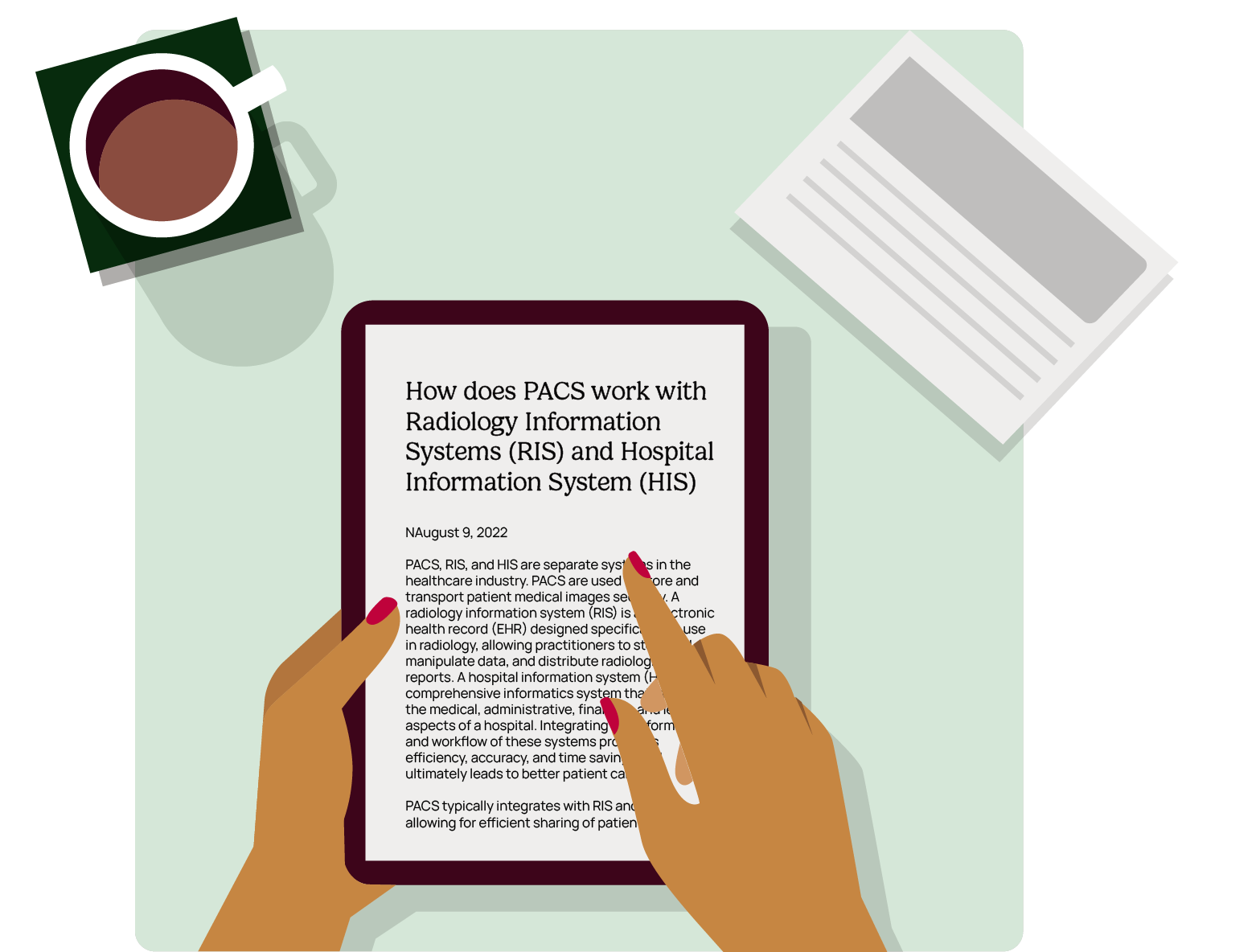August 9, 2022
PACS, RIS, and HIS are separate systems in the healthcare industry. PACS are used to store and transport patient medical images securely. A radiology information system (RIS) is an electronic health record (EHR) designed specifically for use in radiology, allowing practitioners to store and manipulate data, and distribute radiologists’ reports. A hospital information system (HIS) is a comprehensive informatics system that manages the medical, administrative, financial, and legal aspects of a hospital. Integrating the information and workflow of these systems promotes efficiency, accuracy, and time savings and ultimately leads to better patient care.
PACS typically integrates with RIS and HIS, allowing for efficient sharing of patient information between departments. In this article, we will take a closer look at how PACS works with RIS and HIS and discuss some of the benefits of using these integrated systems.
How does PACS work with RIS & HIS
How important is it to integrate PACS with HIS/RIS? The RIS is an essential part of the HIS and shares core functions such as patient registration and order entry components. The benefits of interlinking these important systems are clear as it offers richer patient information plus increases consistency, accuracy, and availability of information.
Clinicians can access and modify the various information which was created and managed in various systems. In the past, these siloed systems would cause issues with redundancy, human error, and slower access to patient information. However, modern advances in integrated systems have alleviated these hassles. Medical facilities using radiology PACS solutions such as the enterprise-grade IntelePACS can rely on a centralized platform to perform the synchronization of data and image management.
As a typical scenario, a patient is admitted to the hospital. They must register, and an order is entered into the HIS. If the patient requires an X-ray, an order is entered and scheduled into the RIS. After the procedure is performed, the images are stored on the PACS and can be retrieved, studied, and shared across multiple departments. Radiologists can make diagnoses from X-Ray images stored in PACS. They can look up a patient’s history and share reports stored in RIS. Furthermore, they can access other pertinent patient information from HIS, such as the patient’s schedule. This is handled by one uniform system rather than having to access multiple systems, saving time, cost and resources.
Technology Is No Longer A Barrier
All of this is made possible due to the implementation of smart software tools. With a zero-footprint viewer such as the InteleViewer, radiologists and technicians can securely access and view patient medical images on any device, including a workstation, laptop, tablet, or smartphone. They are able to view the images any time, from any location, resulting in greater productivity. Increasing diagnostic reading volume while reducing time wasted has proven to have positive impacts on patient care.
Viju Raghupathi and Wullianallur Raghupathi cited these positive implications in a research paper, including the reduction in hospital length of stays, reduction of in-hospital deaths, reduction in or prevention of an increase in the cost of healthcare, and optimization of the rates of admittance in emergency departments/other hospitals/long term care.
PACS fundamentally changed the relationship between radiology in the enterprise. PACS uses the DICOM protocol to communicate medical images. However, modern PACS are not limited to DICOM-only formats, they can receive and distribute non-DICOM formats such as PDF files. RIS and HIS use the Health Level 7 (HL7) protocol. There was an era when this was an obstacle. The enterprise-wide software solutions today traverse this hurdle with a “broker” that translates HL7 messages to DICOM messages for transmission to the PACS.
Artificial Intelligence and PACS RIS HIS
Artificial Intelligence (AI) in radiology is intended to enhance physicians’ capabilities. AI in radiology helps save time and resources, reduce workload by handling tedious tasks, and helps identify anomalies for radiologists, which allows them to make better-informed decisions.
With AI on the rise in usage in radiology departments, the software enhancement extended to worklists has become context-aware by automatically assigning cases to the most appropriate physician, radiologist, or subspecialist based on their specialty, credentials, workload, location, availability, while also factoring in service-level agreement (SLA) requirements and STAT escalation needs.
In Summary
PACS, RIS, and HIS systems have revolutionized the way healthcare information is shared. These systems are integral to the smooth operation of any hospital or medical facility. However, when they are integrated, they promote efficiency, accuracy, and time savings that ultimately lead to better patient care. If you would like to learn more about how these systems work together or see a demo of our software in action, contact us today for a demo. We would be happy to answer any questions you have and help get your business on the path to success.




